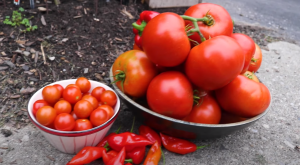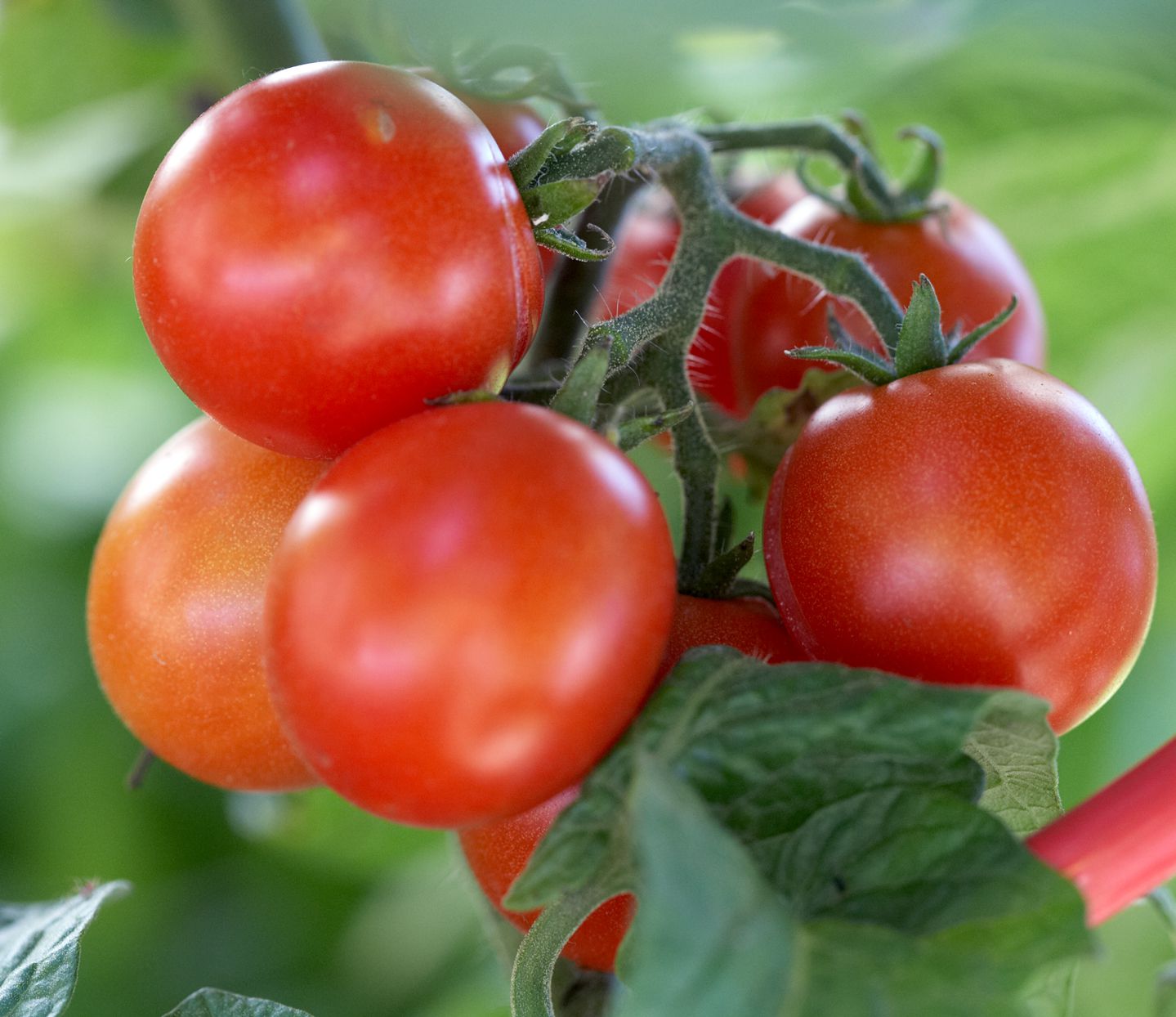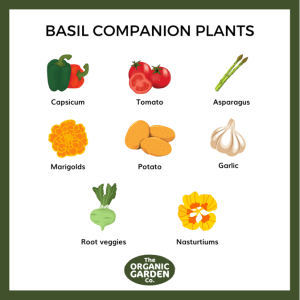Fertilize tomatoes with a balanced fertilizer every two weeks. Use a mix rich in phosphorus and potassium.
Tomatoes thrive with the right nutrients. Start by selecting a balanced fertilizer, ideally with an N-P-K ratio of 10-10-10 or 5-10-10. Phosphorus promotes root and flower development, while potassium boosts overall plant health. Apply the fertilizer every two weeks, ensuring it reaches the root zone.
Consistent watering helps nutrient absorption. Organic options like compost or fish emulsion can also be beneficial. Avoid over-fertilizing, as it can harm the plant. Proper fertilization leads to a bountiful harvest of juicy, delicious tomatoes.
Choosing The Right Fertilizer
Choosing the right fertilizer is crucial for a bountiful tomato harvest. Fertilizer provides essential nutrients that help tomato plants thrive. Understanding the different types of fertilizers and their benefits will guide you in making the best choice for your garden.
Organic Vs Synthetic
Organic fertilizers come from natural sources like compost, manure, or bone meal. They improve soil health and add vital nutrients slowly. This type of fertilizer is eco-friendly and safe for the environment.
Synthetic fertilizers are made from chemicals. They provide nutrients quickly and are easier to measure. They can give an immediate boost to your tomato plants. But, they may not improve soil health in the long run.
| Type | Pros | Cons |
|---|---|---|
| Organic | Eco-friendly, Improves soil health | Slower to act |
| Synthetic | Quick results, Easy to measure | May harm soil health |
Balanced Nutrients
Tomatoes need a balance of three key nutrients: Nitrogen (N), Phosphorus (P), and Potassium (K). These nutrients are often listed as N-P-K on fertilizer labels.
- Nitrogen helps plants grow strong leaves.
- Phosphorus boosts root development and flower production.
- Potassium aids in overall plant health and disease resistance.
Choose a balanced fertilizer with equal parts N-P-K, such as a 10-10-10 formula. This ensures your tomatoes get all they need to grow big and healthy.
To summarize, selecting the right fertilizer can greatly impact your tomato harvest. Understanding the differences between organic and synthetic options, as well as the importance of balanced nutrients, will help you make an informed decision.
Soil Preparation
Preparing the soil is the first step to growing big tomatoes. Healthy soil gives your tomatoes the nutrients they need. Let’s look at how to get your soil ready.
Testing Soil Ph
First, check the pH level of your soil. Tomatoes grow best in soil with a pH between 6.0 and 6.8. You can use a soil pH test kit for this.
| pH Level | Action Needed |
|---|---|
| Below 6.0 | Add lime to raise pH |
| Above 6.8 | Add sulfur to lower pH |
Amending The Soil
Now, let’s amend the soil to make it rich and healthy. Follow these steps:
- Remove weeds and rocks.
- Add organic matter like compost or manure.
- Mix the organic matter into the soil, about 6 inches deep.
Here are some good soil amendments:
- Compost
- Manure
- Peat moss
- Leaf mold
Adding these will improve soil texture and nutrient content.
Healthy soil leads to a big tomato harvest. Start by preparing your soil the right way.
Timing Your Fertilization
Properly timing your fertilization is essential for a bountiful tomato harvest. Knowing the right moments to feed your plants ensures they get the nutrients they need when they need them the most. This section will guide you through the key phases: Pre-Planting and During Growth.
Pre-planting
Before planting, prepare your soil with the necessary nutrients. Start by testing your soil to understand its current nutrient levels. Use a soil test kit to measure pH and nutrient content.
Based on the soil test results, add the required amendments. Common amendments include:
- Compost: Adds organic matter and improves soil structure.
- Bone meal: Provides phosphorus, which is essential for root development.
- Potash: Supplies potassium, crucial for overall plant health.
Mix these amendments thoroughly into the soil. Let the soil rest for a week before planting. This allows nutrients to integrate properly.
During Growth
Tomatoes need consistent feeding throughout their growth stages. Here’s a simple schedule to follow:
| Growth Stage | Fertilizer Type | Frequency |
|---|---|---|
| Seedling | Balanced liquid fertilizer | Every 2 weeks |
| Flowering | High-phosphorus fertilizer | Every 2 weeks |
| Fruit Setting | Potassium-rich fertilizer | Every 2 weeks |
During the seedling stage, use a balanced liquid fertilizer. This supports overall plant growth. Once your plants start flowering, switch to a high-phosphorus fertilizer. This helps boost flower production and future fruit development.
When fruits start setting, use a potassium-rich fertilizer. Potassium is vital for fruit development and overall plant health. Apply fertilizers every two weeks to ensure continuous nutrient supply.
Always water your plants before and after fertilizing. This prevents root burn and helps nutrients reach the roots effectively.

Credit: sowrightseeds.com
Application Methods
Fertilizing tomatoes correctly is essential for a big harvest. The right application method ensures plants get the nutrients they need. Below, we explore two effective methods: Side Dressing and Foliar Feeding.
Side Dressing
Side dressing is a simple and effective way to feed your tomatoes. This method involves placing fertilizer near the plants. It allows nutrients to reach the roots directly.
- First, dig a small trench around each plant.
- Keep the trench about 4 inches away from the stem.
- Next, sprinkle the fertilizer into the trench.
- Cover the fertilizer with soil.
- Finally, water the plants well.
Use balanced fertilizers with equal parts nitrogen, phosphorus, and potassium. This method provides a steady nutrient supply. Repeat side dressing every 4-6 weeks for best results.
Foliar Feeding
Foliar feeding involves spraying nutrients directly onto the leaves. This method allows quick nutrient absorption through the foliage.
- First, prepare a liquid fertilizer solution.
- Use a spray bottle or garden sprayer.
- Spray the solution on the leaves, covering both sides.
- Do this early in the morning or late in the evening.
- Repeat every 2-3 weeks for optimal growth.
Choose fertilizers rich in micronutrients like magnesium and calcium. Foliar feeding is excellent for quick fixes. It helps plants during stress periods.
Both Side Dressing and Foliar Feeding are effective methods. They ensure your tomatoes get the nutrients they need for a bountiful harvest.
Understanding Nutrient Deficiencies
Healthy tomatoes need the right nutrients to grow big and juicy. Sometimes, your plants may not get what they need. This can lead to nutrient deficiencies. Understanding these deficiencies helps you keep your tomatoes healthy.
Identifying Symptoms
Tomato plants show signs when they lack nutrients. Watch for these symptoms:
- Yellow Leaves: This can mean a nitrogen deficiency.
- Purple Leaves: This could be a lack of phosphorus.
- Brown Spots: This may indicate a potassium shortage.
- Curled Leaves: This is often a sign of calcium deficiency.
Corrective Measures
Once you identify the problem, you can fix it. Here are some steps:
- Nitrogen Deficiency: Add compost or manure to the soil.
- Phosphorus Deficiency: Use bone meal or rock phosphate.
- Potassium Deficiency: Add wood ash or kelp meal.
- Calcium Deficiency: Use gypsum or crushed eggshells.
Regularly check your plants for signs of deficiency. This helps you take quick action.
| Deficiency | Symptoms | Solution |
|---|---|---|
| Nitrogen | Yellow Leaves | Add compost or manure |
| Phosphorus | Purple Leaves | Use bone meal or rock phosphate |
| Potassium | Brown Spots | Add wood ash or kelp meal |
| Calcium | Curled Leaves | Use gypsum or crushed eggshells |
Maintaining balanced soil nutrients is key. Healthy soil means a big harvest of tomatoes.

Credit: gardenfill.com
Organic Fertilizer Options
Tomatoes thrive with the right fertilization. Using organic fertilizers ensures a healthy, bountiful harvest. Organic fertilizers improve soil health and provide essential nutrients. Below are some effective organic fertilizer options.
Compost
Compost is a fantastic organic fertilizer. It enriches the soil with nutrients. It also improves soil structure and moisture retention. Here’s how to use compost for your tomatoes:
- Make your own compost using kitchen scraps, leaves, and grass clippings.
- Apply compost to the soil before planting.
- Mix compost into the soil at a depth of 6-8 inches.
- Top dress the soil with compost during the growing season.
Manure
Manure is another excellent organic fertilizer. It provides a steady supply of nutrients. There are various types of manure to consider:
| Type of Manure | Key Benefits |
|---|---|
| Cow Manure | Rich in nitrogen, improves soil structure |
| Chicken Manure | High in nitrogen, phosphorus, and potassium |
| Horse Manure | Good source of organic matter |
Here’s how to use manure for your tomatoes:
- Compost the manure before using it to avoid burning plants.
- Mix composted manure into the soil before planting.
- Apply manure around the base of the plants during the growing season.
Both compost and manure enrich your soil and boost tomato growth. Use these organic options for a big, healthy harvest.
Synthetic Fertilizer Options
Tomato plants love nutrients. To get a big harvest, using synthetic fertilizers can help. These fertilizers provide quick nutrients to the plants. There are two main types: granular and liquid.
Granular Fertilizers
Granular fertilizers are easy to use. They come in small pellets or grains. You can sprinkle these around your tomato plants. They slowly release nutrients over time.
How to Apply Granular Fertilizers:
- Measure the right amount based on the package instructions.
- Sprinkle the granules around the base of the plants.
- Water the plants to help the granules dissolve.
Granular fertilizers provide a steady supply of nutrients. This helps your tomatoes grow strong and healthy.
Liquid Fertilizers
Liquid fertilizers are quick-acting. They are mixed with water and applied to the soil or leaves. This allows the plants to absorb nutrients fast.
How to Use Liquid Fertilizers:
- Mix the liquid fertilizer with water according to the label.
- Pour the mixture around the base of the plants.
- Alternatively, you can spray the mixture on the leaves.
Liquid fertilizers are great for giving plants a quick boost. They are especially useful during the growing season.
| Type | Advantages | Application Method |
|---|---|---|
| Granular | Slow-release, long-lasting | Sprinkle and water |
| Liquid | Fast-acting, easy to apply | Mix with water and pour or spray |
Both granular and liquid fertilizers have their benefits. Choose the one that suits your gardening style. Your tomatoes will thank you with a big harvest!
Common Fertilization Mistakes
Fertilizing tomatoes correctly ensures a bountiful harvest. Many gardeners make mistakes that can harm the plants. Learn about common fertilization mistakes to avoid.
Over-fertilization
Over-fertilization can lead to various problems. Using too much fertilizer often results in excessive leafy growth. This reduces fruit production.
Additionally, over-fertilized plants can suffer from nutrient imbalances. This might cause yellowing leaves or burnt leaf edges. Keep an eye on your plants for these symptoms.
To avoid over-fertilization:
- Follow the recommended fertilizer dosage.
- Use a balanced fertilizer, such as 10-10-10.
- Test your soil regularly to monitor nutrient levels.
Under-fertilization
Under-fertilization can be just as harmful. Tomatoes need nutrients to grow and produce fruit. Without enough fertilizer, plants might appear stunted or weak.
Under-fertilized plants often show signs of nutrient deficiencies. Common signs include yellowing leaves and poor fruit development. To avoid under-fertilization:
- Ensure you fertilize your tomatoes regularly.
- Use a slow-release fertilizer for consistent nutrient supply.
- Incorporate organic matter into the soil to improve nutrient content.
| Fertilization Type | Problems | Solutions |
|---|---|---|
| Over-Fertilization | Excessive leafy growth, nutrient imbalances | Follow dosage, use balanced fertilizer, test soil |
| Under-Fertilization | Stunted growth, nutrient deficiencies | Fertilize regularly, use slow-release, add organic matter |

Credit: gardenfill.com
Frequently Asked Questions
How Can I Increase My Tomato Harvest?
Plant tomatoes in well-drained soil with plenty of sunlight. Use quality compost and water consistently. Prune regularly for better airflow. Mulch to retain moisture. Choose disease-resistant varieties.
What Is The Best Fertilizer For Big Tomatoes?
The best fertilizer for big tomatoes is a balanced mix of nitrogen, phosphorus, and potassium. Look for a 10-10-10 or 5-10-10 fertilizer. Organic options like compost or fish emulsion also work well.
What To Feed Tomatoes When Fruiting?
Feed fruiting tomatoes with a balanced fertilizer, high in potassium and phosphorus. Use compost or organic tomato feed. Ensure regular watering.
How Can I Make My Tomatoes Yield Bigger?
To make tomatoes yield bigger, ensure proper watering, use high-quality compost, and provide adequate sunlight. Prune excess foliage and support plants with stakes or cages.
Conclusion
Fertilizing tomatoes correctly ensures a bountiful harvest. Use organic or synthetic fertilizers for best results. Follow the recommended schedule and dosages. Monitor plant health and adjust as needed. With proper care, your tomatoes will thrive and yield a generous harvest.
Happy gardening!





